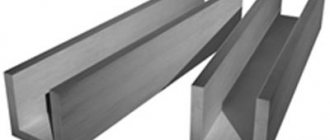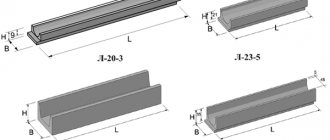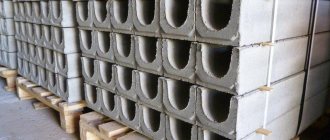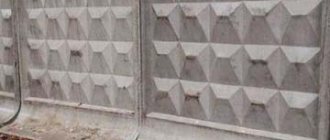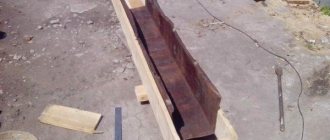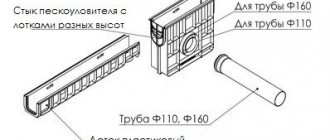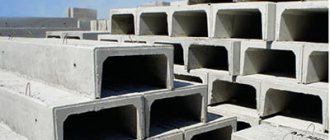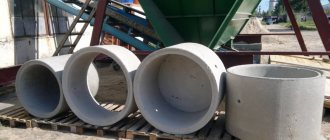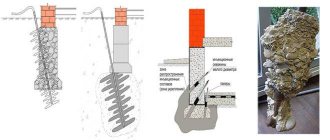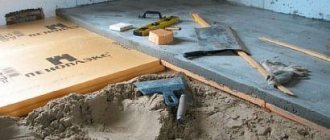Every building owner wants his structure to be reliable, functional, and not subject to destruction not just for years, but for decades. This is a completely natural desire for every person, regardless of what is in his property - a modest country house with a small plot or several huge production buildings of a factory enterprise. In order to fulfill his desire and keep the building in order, its owner regularly checks its condition and carries out the necessary repairs. It is especially important to remember that the condition of a building depends not only on its parts, but also on the site on which it stands. Therefore, building owners know that to take care of their property, installing surface drainage is essential.
Our Company offers you its services for the installation of surface drainage.
Installation of plastic trays.
Installation diagram of plastic trays.
Scheme of joining trays with a sand trap and sewer pipes.
Plastic trays are installed in stages in the following order:
A trench is prepared in accordance with the diagram in the place where the tray will be installed;
-a concrete footing is made by laying concrete in even layers along the bottom of the trench; -plastic trays are located in the trench in the center; - the slopes are concreted to give the system stability.
Plastic drainage trays are connected to each other using the butt method. To do this, there is a tongue on one side of the tray and a groove on the other. To significantly increase the warranty period of plastic trays, the joints are sealed.
To attach the grid to the plastic tray, you must:
Install the main fastening system into the tray by unscrewing the bolt from it; - insert the bolt into the hole located on the grille; - firmly secure the bolt until it stops, checking the reliability of installation; - the stamped grille is attached very easily: the locks located at the edges of the grille are bent, the grille is fixed into the tray.
To make a side connection, you need to make a small hole in the side wall of the tray, connect the trays at right angles, seal and cap.
The advantages of plastic trays are much greater than their disadvantages.
The main advantages are: throughput. Smooth walls are not covered with growths, to which debris can cling and accumulate over time; durability, which is caused by resistance to loads, chemicals, temperature changes; light weight, which facilitates transportation and installation of such a system; several holes, which makes it possible to vary when connecting to a sewer pipe; installation is so primitive that one person can handle it without special education or specific or expensive equipment; Wide area of application - from intensive areas with a large number of pedestrians to small courtyard areas.
The disadvantages of plastic trays are: unreliability at temperatures below zero. Plastic may burst in severe frost or due to the weight of passing traffic; possible deformations over time due to different expansion coefficients of plastic and concrete. In addition, the plastic tray may fall out of the concrete trench over time; Due to the lightness of plastic, it must be pressed when connecting to concrete, which requires additional effort.
Installation of concrete trays.
Scheme of installing a concrete tray in asphalt.
Scheme of installing a concrete tray in concrete.
Scheme of installing a concrete tray in a tile.
Concrete trays are installed in a ditch on a concrete base in asphalt, concrete or tiles.
The thickness of concrete depends on the load class. The base, as a rule, is made of B25 concrete. The sides are fastened in the form of slopes. The width of the slopes also depends on the load class.
The correct deepening of concrete trays is checked as follows: after installation is completed, the extreme point on the grid should be 4 mm below the point of the road. Concrete trays are connected to each other and sealed. If the drain is connected
Installation of concrete trays.
Scheme of installing a concrete tray in asphalt.
Scheme of installing a concrete tray in concrete.
Scheme of installing a concrete tray in a tile.
Concrete trays are installed in a ditch on a concrete base in asphalt, concrete or tiles. The thickness of concrete depends on the load class. The base is usually made of B25 concrete. The sides are fastened in the form of slopes. The width of the slopes also depends on the load class.
at an angle, the concrete tray and lattice are sawn.
When installing concrete trays, one must not forget about expansion joints. The connection of concrete trays is carried out through a sand trap using a 100-160mm pipe or using a vertical pipe installed at the bottom of the tray.
The advantages of concrete trays are obvious - reliability and simplicity, special wear resistance. It should be noted that the scope of application of concrete trays is especially effective in Russia due to its special climatic conditions.
The correct deepening of concrete trays is checked as follows: after installation is completed, the extreme point on the grid should be 4 mm below the point of the road. Concrete trays are connected to each other and sealed. If the drainage is connected at an angle, the concrete tray and grate are sawed.
Concrete trays can withstand severe temperature overloads and retain their functionality. In addition, many concrete gutters and trays are resistant to various mechanical loads. Modern concrete trays are made using a special vibration pressing method; metal inserts are added to improve the class of the product and increase its wear resistance. Some products are made from fiber-reinforced concrete, concrete combined with fiberglass, the characteristics of which include increased impact resistance. An important factor in concrete trays is their correct installation and proper scope of application. Thus, there are general-purpose concrete trays, class C, with a cross-section of 100, and a load of up to twenty tons. For the movement of freight transport, more powerful drainage is required; super-class concrete trays are made for it for maximum load.
The only drawback of the average concrete tray is its low impact strength; this characteristic is especially important during transportation. As mentioned above, for a special type of work, especially strong concrete is made, trays from which are used on runways and in industry. Thus, when installing a concrete tray, you need the help of a specialist who will help you understand the class of concrete required for a specific drainage and install it correctly.
Drainage, as its name implies, ensures the removal of excess precipitation from the territory. While drainage systems save them from excess groundwater that harms the foundations of buildings, surface drainage saves the area from the occurrence of puddles and dirt, which harm the condition of the territory, make it difficult to move around it, and can also become dangerous, turning into ice in cold weather. of the year. Installation of surface drainage solves all these possible problems.
You should only trust such careful work as drainage installation to professional specialists. By contacting a professional company, you can be sure that all work will be carried out in compliance with all sanitary, hygienic, construction and safety standards.
Professionals will tell you in detail about each stage of work, its role in the drainage system, help you select the appropriate equipment, provide and agree on an installation plan. Our company guarantees you exactly this approach to work.
Our employees have significant experience working with such equipment, so we ensure that our customers complete their orders in the shortest possible time. In addition, the opportunity to work with one company from the moment of selecting and purchasing equipment to installing drainage systems will allow you to save money, since we value our customers and offer them the best prices.
The drainage systems installed by our company are always of high quality and reliable, because we work exclusively with proven equipment from the best suppliers. You can be confident that you have received certified equipment that meets all modern technical standards.
We carry out installation work within Moscow and the Moscow region. However, we always strive to meet our clients halfway, so it is possible for specialists to travel to regions close to the Moscow region.
For the drainage system to operate effectively, it is important to comply with all stages of its installation, in particular, the professional installation of drainage trays that collect and directed excess liquid to a specific location. Installation of drainage trays, which are special geometric structures shaped like a rectangle, square or oval, requires care and skill. Such work should only be trusted to experienced specialists.
The preliminary selection of the trays themselves is also important. Do you need trays made of concrete, or are plastic ones suitable? Is it possible to install open trays on your site or is it important to have a special grid? What depth and shape of trays best suit your conditions? Professional consultants from our company will give you answers to all these questions. You will definitely select the optimal equipment, and we, in turn, guarantee you professional installation of drainage trays. The combination of these two factors will allow you to get an excellent result, and the installation of drainage trays will be effective and efficient.
Drainage systems, the installation of which was carried out with high quality, will be effectively used for many years and will not create the slightest problems for the owners of the areas where they are installed. Provide yourself with the best equipment - contact professionals who have proven their effectiveness for installation work, contact our Company!
Drainage trays - plastic, concrete or cast iron - are used in the construction of surface-type drainage systems. Moreover, in such systems the tray “works” as a drainage channel that collects wastewater. Therefore, it is mounted near the road curb, under the sewer pipe, and at the end of the annular blind area.
And in this article we will look at typical types of trays, supplementing the overview of the product range with recommendations for the use of such catch basins in linear drainage systems.
A typical tray is designed in the form of a cast U-shaped channel, the open edge of which is covered with a cast-iron grate.
Moreover, according to the European standard EN 1433, there are at least four types of such water conduits:
- The waste chute is made in the form of a straight gutter that receives water along its entire length (version I is mounted without lining and foundation, version M is mounted on a bedding and is equipped with its own foundation).
- Box-shaped tray - a U-shaped chute, the upper part of which is covered with a removable grid. This element protects the channel of the tray from large objects washed into the gutter by wastewater.
- A slotted tray is a square beam with a round through hole along the central axis, in the upper part of which a slot is cut, allowing access to the drain. Moreover, the gap can be longitudinal continuous or discontinuous. Such a tray can replace a box-shaped analogue with a grid.
- A curb tray is a slotted gutter with an L-shaped protrusion in the upper part that “covers” the gap in the tray body.
Such trays can be mounted not only under gutters, but also near the borders of garden paths. Well, the most durable products can be installed at airports, on highways and in heavy vehicle parking lots.
Range of drainage trays
Methods for manufacturing concrete trays involve the use of a limited set of initially plastic or thermoplastic structural materials during the production of such gutters. Therefore, storm gutters are made from thermoplastic polymers, cast iron and concrete.
This choice is explained by the use of foundry technologies (concrete and cast iron) or thermoplastic extrusion (plastic) in the production process. As a result, the manufacturer produces trays with different strength and performance characteristics.
That is why the classification of the range of trays, in most cases, is associated with the type of construction material used in the manufacture of such a product. And further in the text we will consider the assortments of polymer, cast iron and concrete trays.
Polymer trays
Structural polymer trays are made from mineral-filled polypropylene. This type of composite materials is highly resistant (they are almost impossible to scratch, and they are also inert to most chemicals) and no less noticeable strength (withstands loads of up to 60 tons/m2). And the operating temperature range of such material ranges from -50 to 120 degrees Celsius.
Therefore, such trays can be laid both near the house and near the railway track. Moreover, the weight of one module is only 9-14 kilograms.
Dimensions of a typical polymer tray:
- Length – one meter.
- Width – from 0.14 to 0.5 meters.
- Height – from 0.06 to 0.79 meters.
- The nominal diameter is from 0.1 meters.
Concrete drainage trays with grating
Concrete trays are made from compounds reinforced with fiberglass, polymer threads (polymer concrete) and steel wire (reinforced concrete). Moreover, in the process of manufacturing such products, vibration casting technology is used (a mold with a mass that has not yet hardened is immersed on a vibration stand).
As a result, concrete trays are characterized by high strength, which is unusual for standard reinforced concrete products (reinforced concrete products). Therefore, from such gutters it is possible to assemble both a surface-type home drainage system and its industrial analogue installed on highways and local roads.
Main dimensions of concrete trays:
- Gutter length, which ranges from 500 to 4000 millimeters
- The width and height of the gutter can be changed from 140x150 millimeters to 430x880 millimeters.
- Dimensions of the passage opening, which cannot be less than the catch diameter DN 100.
Specific dimensions of concrete trays are regulated by industry standards and manufacturer specifications.
Cast iron drainage trays
For the manufacture of trays, two types of cast iron are used: with lamellar graphite grain (ISO 185) and with spherical graphite grain (EN1563). Moreover, from these types of cast iron they produce not only the “body” (profile) of the tray, but also its grate.
And, of course, due to the tendency of cast iron to corrosion, the finished tray (and sometimes the grate) is subjected to hot-dip galvanizing (according to ISO 4161). However, a cast iron tray can be supplied to the consumer without a protective coating.
Due to their significant resistance to both longitudinal and lateral loads, cast iron gutters are installed only in critical areas (airports, heavy vehicle parking lots, etc.), where the installation of a cast iron drainage tray is justified from an economic point of view.
Main dimensions of cast iron gratings and trays:
- Maximum length – 500 millimeters
- The maximum width is 200 millimeters.
- The thickness of the grille is at least 50 millimeters.
- The through hole is at least DN100.
Classification
Considering the purpose of the trays, the materials used in their production must be quite plastic, and the design of drainage trays directly depends on their properties. Today, polymers, cast iron and concrete are used to make drainage trays. These materials were chosen for a reason: concrete and cast iron are very suitable for use in foundry production lines, and plastic is perfectly processed by thermoplastic extrusion. The result is a fairly wide range of trays made of different materials, which means that all these devices have different properties. Since the design and characteristics of the tray directly depend on the material, drainage trays are usually classified according to the type of raw material used for their production.
Installation of drainage trays: basic rules
Installation of drainage trays is a very responsible operation. After all, the surface drainage system is located in a complex soil, which includes sandy loam and fertile soil. That is, you can’t count on high supporting ability.
In addition, such soil freezes 1-1.2 deep almost every winter. Therefore, heaving deformation will also act on the supporting surface of the tray, pushing the product out of the soil.
That is why when installing drainage trays you should be guided by the following set of rules:
- First, select a tray based on throughput capacity, based on the average monthly precipitation increased by 25 percent.
- Secondly, choose the optimal tray design and the material from which the product will be made, based on the location of the gutter. After all, a curb tray is not suitable for an airfield (based on its strength characteristics). In turn, the airfield tray will not fit into the home stormwater system (based on economic considerations).
- Thirdly, the minimum slope of a linear meter of the tray is 10 millimeters.
- Fourthly, do not skimp on the substrate - mount the tray on at least a 10-centimeter sand and gravel backing, or better yet, on a 10-centimeter gravel backing. Such a “cushion” will improve the strength characteristics of the soil and partially neutralize heaving deformation.
- Fifthly, stainless steel grates are easier to install (they weigh less than the cast iron version). In addition, they will last longer than their counterparts made of gray or ductile iron.
- Sixthly, the system must have a sand trap - the only protection of the drainage system from silting.
- Seventh, the grille must be secured using a special mechanism with a screw lock.
First, select a tray based on throughput capacity, based on the average monthly precipitation increased by 25 percent.
First, select a tray based on throughput capacity, based on the average monthly precipitation increased by 25 percent.
The process of assembling a drainage system based on drainage trays is implemented as follows:
- Along the curb or in another place chosen by the designer, the center line of the future drainage system is marked. To do this, just use pegs and twine.
- After this, meteorological observation data is requested, and based on this information, the average daily volume of runoff is determined, according to which the throughput diameter of the gutter is selected.
- The model and external dimensions of the water pipeline are determined by the flow diameter.
- Based on these dimensions, increased by 30-40 centimeters, the volume of soil excavation (trench dimensions) is determined. Moreover, the depth of the trench will be 10-15 centimeters below the height of the tray. After all, its edge, after installation, should be located below the zero level by at least 5 millimeters.
- At the next stage, a trench is dug, the selected soil is disposed of and a bedding is formed, with the help of which the slope is outlined and the bottom of the “pit” is strengthened.
- Next, drainage trays and sand traps are placed in the trench. Moreover, the outer catcher is connected with a DN100 pipe to the main (deep) drainage system.
- After this, concrete is poured into the space between the trench wall and the tray, fixing the drainage system in the selected location.
This drainage system is installed along the central paths on the site, laid between the gate and the entrance to the home. In addition, a ring water conduit is “circulated” around the blind area, which protects the soil from rain runoff. Moreover, a wall drainage system can be assembled from plastic, while a road drainage system can be assembled only from concrete blocks.
Installation of surface drainage trays
This is one of the simplest construction processes, which includes several stages:
- marking;
- carrying out excavation work - digging trenches according to markings;
- leveling the bottom of the trench with sand;
- installation of channels with the required slope with sealing of connecting joints;
- filling trays on all sides.
Installation of surface drainage trays
Despite the apparent simplicity, it is necessary to take into account a large number of nuances:
- First of all, the density of the soil and its type are taken into account. The denser, the lower the water absorption.
- Installation begins from the lowest point of the drainage main - from the place where water is collected into the sewer or discharged outside the territory.
- The depth and width of the trench should be 10-15 cm greater than the same parameters of the channels themselves.
- Grids of the surface drainage system should be located 3-5 cm below the final finishing of the territory (below asphalt, paving slabs and other materials).
- Installation of plastic channels is carried out together with gratings. This is how the shape of the products is preserved.
- Before installation begins, a thread is stretched over the trenches to determine the slope of the channels. To do this, several pegs are driven into the ground, to which the thread is attached.
- Heavy gutters are lowered into the trench using lifting equipment. Lightweight by hand.
- Sealants are laid between the elements of the drainage line to ensure sealing of the connections. For plastic ones, a polyurethane sealant similar to an adhesive composition is used. Concrete ones are connected with cement-sand mortar or special gaskets, round in cross-section. The latter are also used in joining metal elements.
- To increase the stability of the location of surface drainage trays, they are sprinkled on both sides with semi-dry concrete mortar, which subsequently becomes the basis for finishing the adjacent area.
- Installation is carried out strictly along the tensioned thread. Each channel is additionally checked with a building level to control the installation level.
- If large-sized concrete trays are being installed, the bottom of the trench is thoroughly prepared. A sand cushion 10-15 cm thick is poured in, and a concrete base for the channels 10 cm thick is formed on it. It is this that is laid at the required slope, so as not to align the gutters themselves to the angle of inclination.
The variety of surface drainage trays made it possible to expand the choice. After all, surface drainage is part of not only public places and industrial facilities. Today it is part of the landscape design of suburban areas, which is subject to functional loads. Therefore, the appearance of plastic trays on the market solved many of the problems of country developers.
Information sources:
- https://gs16.ru/dacha/razmery-vodootvodnyh-lotkov-2.html
- https://opzt.ru/wp-content/uploads/2019/08/GOST-R-Lotki-ZHB-1-red.-04.24.2019.pdf
- https://stroy-podskazka.ru/drenazhnaya-sistema/lotki/#h3_282336
- https://gk-azimut.ru/blog/obzory-tovarov/tipy-vodootvodnykh-lotkov-i-ikh-razlichiya
- https://septikexpert.com/ochistnye-sooruzheniya/drenazh-i-livnevaya-kanalizaciya/lotok-vodootvodnoj
- https://www.standartpark.uz/info/articles/polimerpeschanaya-ili-polimerbetonnaya-tekhnologiya
- https://strojdvor.ru/kanalizaciya/lotki-vodootvodnye-polimerbetonnye
- https://septicov.net/lotki/plastikovye-lotki/plastikovye-vodootvodnye-lotki.html
- https://www.drenag54.ru/articles/1375
- https://www.inoxpark.ru/catalog
Features of drainage trays
Design and purpose
Drainage trays have a simple design. The product is a part in the form of a rectangular linear beam in which a gutter is made. If the tray is made of plastic, then it is U-shaped.
The purpose of a drainage tray can be understood from its name: collecting and draining water from the surface of paths, platforms, blind areas and other waterproof coatings. This is an important element of the site system.
A tray is a device that will help keep the area clean and well-groomed. Additionally, draining water around your home extends the life of your foundation.
A well-designed and constructed storm drain is essential if you want a site with beautiful landscaping and healthy plants, without puddles on the paths or dirt in the garden.
Types of trays
Drainage systems are used very widely, so there are a variety of trays for draining water. Concrete products are most often used.
But modern industry produces gutters from a variety of materials:
Disadvantages - heavy weight and more complex installation, fouling of the gutter with algae, silt and sediment.
Disadvantage: low strength and poor adhesion to concrete.
The disadvantage is high corrosion activity, so it is better to choose galvanized cast iron.
Trays for draining sediments may differ in such parameters as the maximum permissible load. Depending on this indicator, products are divided into classes:
- A15. Gutters of this class can withstand 1.5 tons of load and are used in local areas, sports fields, parks and pedestrian paths;
- B125. This class can withstand 12.5 tons and is used on roads for passenger cars, parking lots, and garage complexes;
- C250. Trays of this class can withstand 25 tons of load. They are used in parking lots, gas stations, car washes and other car service facilities;
- D400. These gutters can withstand 40 tons of maximum load. Their scope of application is wide: high-traffic highways, freight transport terminals, small enterprises, industrial zones;
- E 600. The products can withstand a load of 60 tons. They are used at piers, warehouses, large industrial facilities, road junctions and logistics centers;
- F900. This is the most durable class, capable of supporting up to 90 tons. Such trays are installed at airfields, military bases, heavy equipment parking lots, and at large mining enterprises.
For drainage of suburban areas, trays of classes A15 and B125 are used. The first are installed in a pedestrian area, the second - in places where a car can pass.
Surface drainage system components
For household plots with a large area, trays alone may not be enough to drain the required amount of water. Over a large area, it is better to place several components designed to drain groundwater, melt and rainwater into the sewer system. These include:
what the drainage system includes, list of elements: raincoats, sand trap, grids for trays,
- Sand traps
- Storm water inlets
- Drainage trays
- Drainage grates
- Storm drain gratings
The second component is designed to collect water from the roof of the site. It is used for both storm and precise drainage. Trays, as you already understand, are responsible for transporting water to the sewer.
At the same time, drainage grilles protect the process from unnecessary debris. The gratings for the rain inlet protect the specified element from the ingress of stones and other dimensional components.
Installation of water drainage trays
Tool
It is quite possible to do the installation of drainage trays yourself. To do this you will need desire, technical savvy and a set of tools.
The most common tool needed:
- shovel,
- Bulgarian,
- level,
- thread,
- marker,
- rubber hammer,
- Master OK,
- basin for solution,
- construction knife,
- chisel,
- an ordinary hammer.
In addition, the technology requires the presence of a drawing or diagram according to which the trays will be installed. If you don’t have a professional document, draw the installation diagram “by hand” so that you don’t confuse anything during the work.
Step-by-step installation
The drainage system includes trays and a sand trap. The latter is installed at the lowest point. From it water flows into.
There is a special basket inside the sand catcher where settling debris and sand accumulate. Don't forget to clean it!
Instructions for installing concrete trays:
Purpose
Reinforced concrete trays (RCTs) for heating mains, due to a wide range of standard sizes, are used not only for their intended purpose, but also for other purposes, both in households and in the construction, municipal, and industrial sectors.
Reinforced concrete trays for heating mains play the following role:
- They protect water, gas, steam pipelines or cables from the physical pressure of the soil placed above them.
- They provide additional thermal protection for the pipeline, while saving money on heating water, steam or other coolant.
- Since the underground tray is covered with a protective cover on top and coated with waterproofing on the outside, moisture does not penetrate into it - in this way, internal utility lines are protected from corrosion.
- Also, the reinforced concrete tray for the heating main does not allow the pipeline to come into contact with the soil, various biological organisms and animals. This increases the corrosion resistance of the pipeline and significantly increases its service life.
- A concrete tray for the heating main protects the pipeline from the physical impact of the soil during subsidence, displacement as a result of earthquakes or erosion by groundwater.
- One of the popular uses of trays is to install them to drain various liquids. They can be used in the livestock farming industry on livestock farms for transporting liquid manure and organizing water supply channels. In land reclamation, trays are used for draining swampy areas. When running a household farm, using trays, you can supply water to the site from open sources, wells, pumps, and create channels for draining water from the territory.
Reinforcement schemes
Conclusion
We looked at drainage trays, their features, types and installation rules. Now installing the gutter yourself should not cause you any difficulties. To consolidate your knowledge, watch the video in this article. And ask questions in the comments.
Before installing drainage trays, it is necessary to determine which objects and places most need protection from melt and rain water. These can be sidewalks, roads, buildings or entire areas. Considering that all the moisture accumulates in the lowlands, the main drainage system is first organized there and connected to the general drainage. Subsequently, it is there that the lines and slopes of drains are directed from the perimeter of the site, housing construction, paths, and on the scale of settlements from streets, sidewalks, squares and park areas.
Installation of drainage trays begins with an assessment of their strength and load-carrying capacity, depending on the location of their installation:
- on runways they use F900 tray blocks - with a lifting capacity of up to 90 tons;
- on areas and roads related to warehouses, logistics centers, industrial enterprises, with lifting capacity E600 - up to 60 tons;
- on transport highways, automobile enterprises and industrial zones, where the movement of all types of automotive equipment is provided, D400 is used - up to 40 tons;
- near workshops, services, car washes, gas stations serving all types of transport, they lay C250 - up to 25 tons;
- in areas where there is traffic for passenger cars, including garages, garden plots and parking lots, use B125 - up to 12.5 tons;
- under garden paths, pedestrian crossings, sports grounds, bicycle paths, it is recommended to install A15 - up to 1.5 tons.
Step-by-step installation technology:
- Marking and digging a trench along the external dimensions of the trays, taking into account the slope towards drainage, the height of the concrete pad is at least 100 mm. and deepening the grate under the level of asphalt or cement-sand coating at least 4 mm. For low-strength polymer products, it is necessary to fill walls with a thickness of at least 90 mm.
- Preparing the solution and laying the pillow
- At the beginning, a sand trap is installed on the damp concrete pad, and at the end, a pipe is installed to interface with the drainage system so that an optimal slope for drainage is provided, then a string is pulled between them.
- At the level of the string, blocks are laid on the raw mortar, simultaneously sealing the joints.
- After the concrete has completely dried, the side cavities are filled with appropriate material. In particular, the sidewalls of low-strength polymer products are filled with a solution.
- In the direction of the drainage line, special expansion joints are created using notches at a distance of 20 mm from each other, in order to avoid deformation of the tray system due to seasonal temperature changes.
- At the final stage, gratings are installed.
- In places where it is planned to organize a road surface, metal sheets are laid on the grid, the thickness of which is selected taking into account the expected load.
Further operation of the complex for collecting and draining melt and storm water comes down to periodic cleaning of the sand trap and ditch up to the connection with the drainage pipe.
Drainage trays are simple parts designed to create an open rainwater drainage system. Recently, the use of plastic trays has become widespread, as they are much more convenient than concrete ones. Let's look at how to select parts for a rainwater drainage system and install drainage trays.
An open rainwater drainage system copes with the assigned tasks quite effectively; its construction requires minimal expenditure of finance and labor.
The system has been in service for many decades, and its maintenance is extremely simple. The main element is a tray, closed on top with a protective grille to prevent debris from entering. You can assemble the system using concrete trays, but recently plastic trays have become much more popular.
Basic terminology
Drainage trays with gratings have incorporated certain formulations into their concept:
- Stormwater wells - the depth characteristics of such containers vary depending on the expected operating conditions. Such wells are mounted to storm drains;
- well for collecting sand - this container is designed to collect grains of sand, soil elements, and other solid objects. The element is made of several parts mounted into one sealed structure. Sand catchers that have one part are often used;
- waste bins are removable parts. They are classified as drainage trays and wells for collecting sand. This is where solids and debris accumulate. To remove them, the basket is removed from the well and cleaned;
- nominal value of the tray width – a design parameter, corresponds to the largest integer parameter of the tray in millimeters, taken horizontally;
- supporting tray surface - a reinforcement attachment, additional elements, and sometimes gratings are installed on it;
- reinforcing attachments - a construct necessary to protect other open-type elements from various damage likely from interaction with motor vehicles;
- contact surfaces – top of pads for reinforcement.
What are the advantages?
Why, when comparing concrete and plastic trays for a storm drainage system, do most developers choose parts made from polymer materials? The fact is that plastic trays are much more convenient, because they are durable, lightweight and have an affordable price. It is especially beneficial to use such parts when constructing rainwater drainage systems in areas near private houses and summer cottages, since in this case there is no significant physical stress on the drainage system.
Advice! Plastic trays are equipped not only with a horizontal, but also with a side fastening system, so they can be used to easily rotate. In addition, if necessary, you can connect the tray to the sewer pipe. This may be necessary if a mixed storm sewer is being built, when part of the system is laid underground.
Advice! Plastic trays are equipped not only with a horizontal, but also with a side fastening system, so they can be used to easily rotate. In addition, if necessary, you can connect the tray to the sewer pipe. This may be necessary if a mixed storm sewer is being built, when part of the system is laid underground.
Unlike conventional concrete trays, plastic products have a perfectly smooth inner surface. Therefore, the storm flow moves freely without hydraulic resistance. In addition, the absence of roughness on the bottom and walls significantly reduces the risk of clogging the system with sand and silt.
However, the main advantage of plastic trays, which distinguishes them from their concrete counterparts, is their low weight, which greatly facilitates transportation, loading and unloading and installation. Plastic parts, unlike concrete ones, are easy to process; they can be very easily shortened or cut at the desired angle.
What is surface drainage
Surface drainage, especially in combination with a drainage system, rids streets and courtyards of dirt and puddles, and prevents acidification of the root system of green spaces. Hidden by decorative gratings, the concrete drainage tray is not noticeable and “works” unnoticed.
The edges of the trays are reinforced with steel/cast iron cornersThe drainage line is a string of trays connected to each other. Accompanying elements of the system are sand traps, water intake grates, vertical weirs, and fasteners.
Manufacturing by vibration pressing gives the product:
- Solidity, enhancing its hydrophobic properties and mechanical strength.
- Smooth inner surface to prevent silting.
Covers for trays are made from cast iron with graphite additives, copper alloys, rolled/stainless steel, reinforced concrete, polymer concrete. Reliable fixation of the grille is achieved using a locking mechanism/large weight of the product.
Concrete gutter in the yard: pros and cons
The arrangement of drainage on roads, bridges, and national economic facilities is carried out using special equipment. The question arises: does it make sense to undertake such hard, long work in your own yard?
Concrete ditches give the landscape a fabulous look
Advantages:
- The concrete storm channel is resistant to any water pressure;
- Insensitive to temperature changes and various types of loads;
- The material is neutral to aggressive environments;
- Durability and unpretentiousness of the system;
- Asphalt/tile repairs do not require dismantling the gutter.
Concrete storm drain is indispensable in the yard
Also, a concrete tray has inconveniences that can be called characteristic:
- Designed for linear drainage only.
- Heavy trays will require transport for delivery and installation of the system.
- Labor-intensive installation.
The cost of one tray ranges on average from 200 to 900 or more rubles (prices are valid for spring 2022). The price of a concrete gutter depends on several parameters:
- Tray sizes;
- Availability of a vertical drain;
Tray with vertical overflow
- Grate material;
- Number of resellers.
Kinds
Plastic trays for rainwater drainage come in several types. Let's look at what options there are.
Universal
These details fully live up to their name. They can be used in a wide variety of areas. The parts are easy to install; they are often chosen for organizing storm drainage for a summer house or a personal plot near a house. They can be used in cases where the depth of the elements of the drainage system is standard.
Advice! Since the trays are covered with durable bars on top, their use is safe, even if children often play in the area.
Advice! Since the trays are covered with durable bars on top, their use is safe, even if children often play in the area.
Deep
If a stormwater drainage system is being built in an area where precipitation is heavy, deep trays should be selected. These parts are capable of draining large volumes of water from the territory. If, under such conditions, parts with a shallower depth are installed, the drainage system will quickly fail due to silting.
Extra strong
The difference between these plastic products is the presence of additional stiffeners. It is recommended to use the following storm drainage elements:
- in car parks;
- on the territory of garages;
- on the roadway.
Advice! Since the installation of extra-strong trays is expected in public areas, the models are equipped with anti-vandal fastening of the gratings.
Advice! Since the installation of extra-strong trays is expected in public areas, the models are equipped with anti-vandal fastening of the gratings.
Wear-resistant
These are storm sewer elements that are designed for use in particularly difficult conditions. They are designed for increased loads and are highly durable, as they are additionally reinforced with steel plates. This type of trays can withstand pressure of several tens of tons and ensures rapid drainage of rainwater.
Advantages of surface drainage compared to storm water inlets
The surface drainage system involves the use of separate trays that are joined together. The trays cover the entire perimeter of the surface from which water must be drained. The channels are closed from above with gratings designed to protect the passages from blockages by debris washed into them. Such systems allow safe movement of pedestrians and vehicles through the territories. In addition to surface drainage systems, hard surfaces can also be equipped with point drainage systems (rain inlets). Water intake points are located evenly throughout the drained area. They are connected to each other by underground pipes that drain water into the sewer system.
Surface linear drainage from plastic trays has the following advantages compared to storm water inlets:
- installing such a system is more profitable from a financial point of view, since the installation of trays is easier and faster. It also requires fewer materials to create drainage on the surface;
- the ability to lay trays almost anywhere on a hard surface. Point drainage has restrictions on location due to the presence of underground communications;
- surface drainage is easier to install;
- there is no need to create external slopes towards storm water inlets. The surface remains level and suitable for the movement of people and vehicles.
- Maintenance of surface trays is several times simpler than maintenance of a point drainage system.
Read about the types of drainage systems in another article: Drainage around the house.
An example of surface drainage using trays
How to install?
To assemble an open storm drain system, in addition to the trays, you need to prepare:
- sand;
- sealant;
- concrete solution.
In addition, if mixed rainwater drainage is installed, it is recommended to include a sand trap in the system, this will ensure normal operation of the drainage system. This element is installed at the junction of open trays with sewer pipes.
Installation of trays
The work is carried out as follows:
- The territory is marked according to the developed project;
- Trenches are dug in the designated locations. Its depth depends on the height of the tray used. This element is installed so that its edges are 5 cm below the ground level. In addition, you need to make a “reserve” of depth for installing a sand or concrete base;
- for the system to work effectively, the channels must be laid with a slope, the slope value is 1 cm per linear meter;
- the bottom of the prepared trenches is processed using a manual tamper. Then a layer of sand 5 cm thick is poured. If the soil in the area is weak, then it is necessary to provide a concrete base. In order for the trays to last longer, it is recommended to completely concrete the trenches, that is, cover not only the bottom, but also the walls with concrete mortar;
- the elements of the drainage system are being installed, and care must be taken to ensure that the slope is maintained;
- individual elements are joined to each other using special latches. To make the system more reliable, it is recommended to treat the joints with a special adhesive-sealant. It is important to choose a product that is resistant to high humidity and low temperatures;
- Grates are installed on top of the installed elements of the drainage system.
Reinforcement and filling of the tray
When making a mesh of reinforcement rods, you need to place them at a distance of 5–10 cm from each other, both vertically and horizontally. The mesh can be tied together with knitting wire or welded using electric welding. To prevent the reinforcement in the tray from rusting or rotting, the edges of the rods should not reach 5 cm from the wall of the formwork and the molding part.
While the reinforcement is laid, it is possible to pour the formwork. How to make concrete correctly was outlined above. During pouring, it is necessary to use a construction vibrator - a device needed to compact concrete and remove air bubbles and excess water from it. If it is not there, it is possible to take a piece of reinforcement or something similar and compact the concrete with an “up and down” motion.
When the concrete is poured, you must immediately use the molding part from the pipe, thanks to which the top of the form will be in the form of a semicircle. For a better result, it is possible to sprinkle the top of the poured form with dry cement, which was used in the manufacture of concrete, in order to “harden” the surface, in other words, to give it greater strength. And you can not only press the pipe into the fresh mixture, but also rotate it a couple of times in different directions, without applying too much pressure - this way the semicircular surface will have great smoothness.
It takes 28 days for concrete to completely harden. But after just a few days, the formwork can be disassembled - the concrete has reached the stage of preliminary hardening, in other words, it has not gained full strength, but it will not fall apart in your hands. The resulting tray should be rectangular in shape, and its internal cavity should be semicircular, smooth, without pits, cracks or other imperfections.
What does the title of the series say?
You can recognize the manufacturer by the name of the series of drainage trays. For example:
- LB series BetonPark, BetonBasis, BetonNova - Mordovian;
- Plus, Norma, Optima - “Aquastok” Krasnodar;
- Maxi LV, BGF, BGU - St. Petersburg.
How to “read” a concrete tray:
- The combination of several numbers after the name of the series means the product article, for example, Maxi LV-11.19.13-B. Any types of trays can be easily found by article number in the catalog;
- The letter combination DN denotes the European standard - 100, 150, 200, 300, 500 mm, indicating the internal width of the tray. Domestic manufacturers use Soviet standards - 100, 110, 150, 160, 200, 300, 500 mm. The presence (sometimes) of a second digit separated by a fraction indicates the depth of the product, for example, DN 100/132;
- L — length (standard — 500–3000 mm, additional — 500–700 mm, extended — up to 6 linear meters);
- B - outside width (400–1900 mm);
- H – height (380–1500 mm);
- The mass and weight of the product are indicated in the metric system.
The main advantages and disadvantages of concrete blocks
The structure allows water flow to be directed into the general city storm sewer system. With proper planning, the desired area will be free of puddles and dirt after precipitation. Concrete trays preserve the properties of surfaces and the quality of the soil, so they are used near railways, highways, heating mains, and streets. Modern concrete gutters are made by vibration casting or vibration pressing. They have a number of positive features:
Advantages and disadvantages of concrete blocks
- Strength, wear resistance to any water flow and mechanical stress.
- Easy to install.
- Waterproof.
- Tolerance to temperature changes.
- The material withstands aggressive environments well.
- Monolithic structure.
- Due to the smooth inner surface, dirt does not linger in the structures, which eliminates silting.
- Precise geometric shapes.
- General purpose concrete trays can withstand loads of up to twenty tons, which corresponds to class C.
- If the product is made of concrete with the addition of fiberglass, it acquires high impact resistance.
- Has a long service life.
- Repairing the road surface does not require dismantling the device.
Thanks to additional steel reinforcement, concrete trays can withstand particularly heavy loads on the road surface, corresponding to the special class F 900.
While there are many advantages, there are some disadvantages:
- Suitable for linear sewerage only.
- The heaviness of concrete gutters makes transportation and installation difficult.
- High shipping costs.
Ditch tray
FER 2001-30 Federal unit prices for construction work. Collection 30. Bridges and pipes
Reinforced concrete cable tray is a structure that is used quite widely. In the article we will talk about the main types of reinforced concrete trays, and also specifically focus on those that are best suited for solving our problem. When carrying out construction work, as well as when laying roads, it is very often necessary to allocate areas through which communications will pass - wires, pipes, etc. At the same time, an important task is to preserve the integrity of the objects being laid, and therefore a variety of designs are used to protect them, find out here, how to concrete in cold weather.
Methods for making drainage trays
The main method of manufacturing concrete trays at reinforced concrete factories is vibration casting. This method eliminates the formation of internal defects (voids, cavities, pores). This is not direct concrete casting, but a special pressing technology using vibrations. Concrete drainage trays made using vibropressing technology have increased strength characteristics.
The technology for producing drainage trays at different factories may differ slightly. Production capacities dictate their own rules and this cannot but affect the quality.
Modern industry offers improved technologies for producing drainage systems. Reinforcement or hardening of concrete occurs with special fiberglass or fiber fibers. Such trays not only have the characteristics characteristic of “ordinary” reinforced concrete, but are characterized by lower weight, lower price and increased strength characteristics. A progressive and high-tech enterprise must follow new trends and “trends” in the field of reinforced concrete products.
Within the huge plant, manufacturing technology is 100% followed and all standards are met. When choosing drainage trays, you should first look at the manufacturer. In Russia, the production of high-quality trays has been established in many factories. One of the leaders is a manufacturer of reinforced concrete products from Safonovo, Smolensk region. The full catalog is presented here.
Production of concrete trays
Concrete trays are available in a wide variety on the market, but if you wish, you can make them yourself.
Factory production
The production of trays at enterprises is carried out using vibration casting and vibrocompression technologies.
The second option is more expensive, but the characteristics of the resulting products in terms of strength and resistance to moisture and aggressive environments are higher.
Vibratory pressing technology for concrete trays:
- A concrete mixture is prepared from Portland cement M400, sand, small or medium crushed stone (in a ratio of 1:2:4) with the addition of water.
- The solution is poured into the mold placed under the press.
- The products are pressed, as a result of which excess moisture and air are removed from the concrete.
Vibropressing of concrete trays
Reinforcement of products is carried out with steel rods and wire, treated against corrosion, with a cross-section of 5-6 mm. In this case, the thickness of the concrete layer up to the installed reinforcement must be at least 15 mm. It is also possible to reinforce the trays with fiberglass or polymer fiber.
Making your own trays
To produce trays with your own hands, you will need to make “U”-shaped equipment from plywood or boards. It is better to lay plastic film on the inside to make it easier to dismantle this formwork and not spoil the surface of the tray. To mold the products you will need halves of a sewer pipe.
So what is next:
- The concrete solution is mixed.
- For reinforcement, steel wire with a diameter of 5 mm or fiberglass is used.
- The solution is poured into the prepared form.
- Half of the pipe is pressed in from above, which will form a recess with a smooth surface for the unhindered movement of water.
- After a day, the structure can be disassembled. The tray is left to gain strength.
https://youtube.com/watch?v=jrdXyTOx5Bg
Features of plastic sections
Plastic trays are made from high-quality polymer materials - polypropylene or polyethylene. For manufacturing, only frost-resistant polymer material with increased resistance to shock loads and the ability to withstand significant temperature changes is used. However, products may differ in the following characteristics:
- according to the maximum permissible load;
- by capacity;
- all elements differ in dimensions and internal section size;
- trays can come with or without a grid.
Plastic trays have the following advantages over products made from other materials:
- Light weight makes the sections easy to transport and install. For example, one plastic element, depending on the design, will be 30-70 times lighter than its concrete counterpart.
- Thanks to the simple and hermetically sealed connection, the line can be assembled by one person without using any auxiliary equipment. On sale there are elements for lateral joining, as well as transition pipes for joining with sewer networks. Thanks to this, the installation of T-shaped and corner elements is greatly facilitated, and the connection of the entire system takes place in a short time.
- Versatility. If the installation requires it, the plastic channel can be shortened with a hacksaw to the required length. At the same time, the performance characteristics of the product will remain at the same level.
- The service life of such a tray reaches 50 years thanks to the use of high-quality plastic.
- Resistance to temperature fluctuations and mechanical stress.
- The material is not exposed to ultraviolet radiation and can be used at temperatures from -40 to +95 degrees.
- All polymer materials are resistant to various aggressive chemical substances (acids, alkalis, automotive fluids and winter street treatment products).
- Due to the fact that the surface roughness coefficient is much lower than that of concrete, the throughput of the tray is much higher. And this is with the same hydraulic cross-section of the elements.
- These are universal products that can be used in soils of varying complexity.
- In addition to the reasonable price of the plastic product, savings can be achieved by reducing transportation and installation costs.
Specifications
Plastic sections are produced in accordance with GOST standards number 26996-86. The Rockwell hardness of the product is 70. The bending elasticity coefficient is 750 MPa. In addition, depending on the type, the plastic tray has the following technical characteristics:
- The dimensions of the internal section can range from 100 to 300 mm.
- Plastic elements are classified according to load class from A15 to E600.
- The throughput of the sections can range from 1.8 to 34.9 l/sec.
- The weight of one element is from 1 to 6.85 kg.
Installation methods
There are several methods for arranging a drainage system using reinforced concrete fibers:
- Overlapping. The products are placed with some overlap on each other. For these purposes, trapezoidal trays are used: the narrow part of the next tray fits into the wide one of the previous one.
- Groove. This method is used if trays are laid at an angle or in a horizontal direction. Each product has a groove on one side and a protrusion on the other. During installation, the trays “snap” together. Very simple.
- Butt. This is used for arranging a drainage system that is not designed for heavy loads.
Important! To ensure the system is waterproof, the gaps between the products are sealed using cement or special polymer compounds
